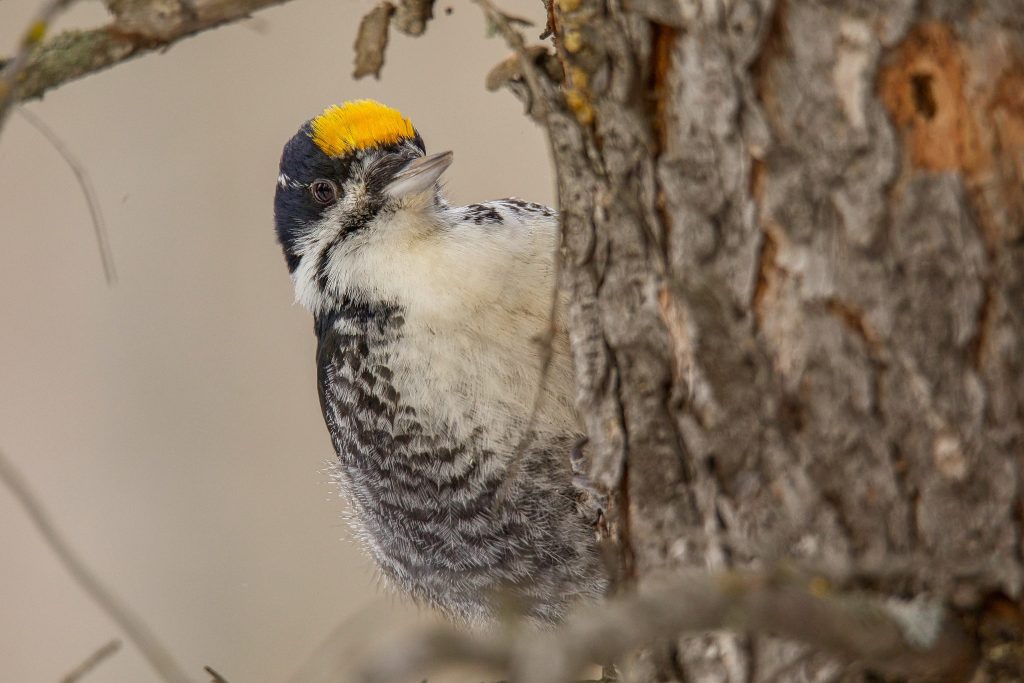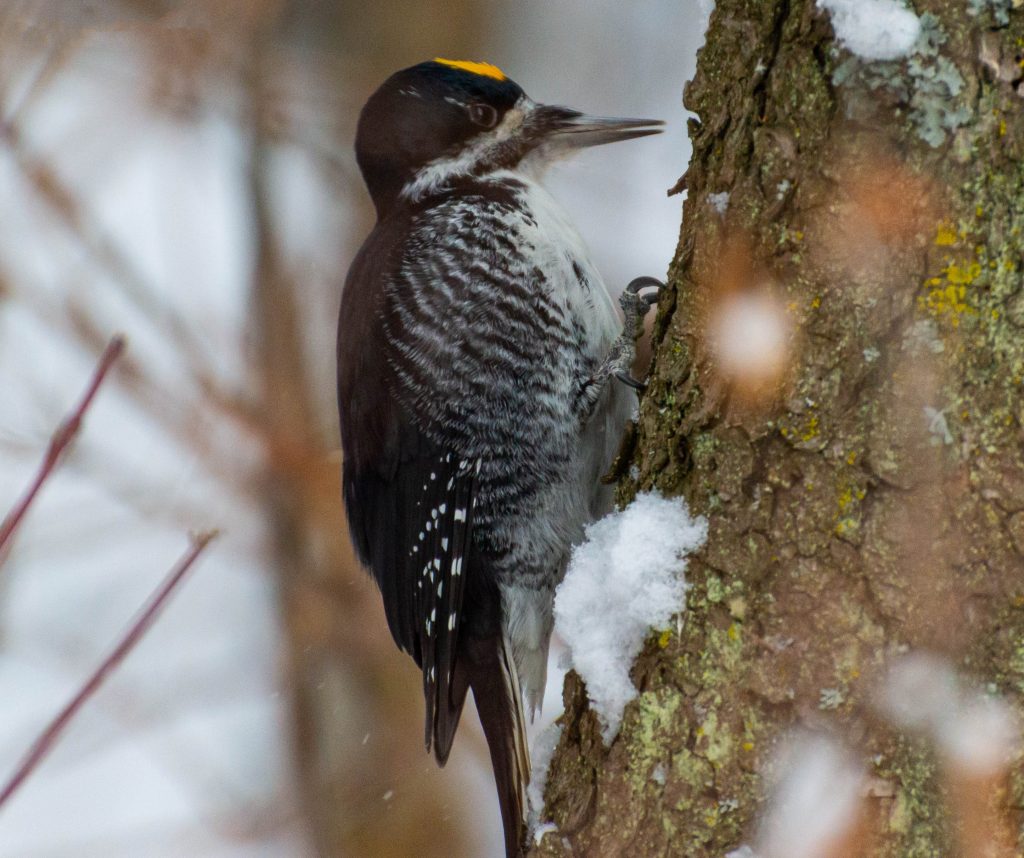Alberta’s “Other” Woodpeckers

A male three-toed woodpecker. In this species as well as black-backed woodpeckers, males have a yellow patch on the top of the head, instead of the red patch seen in other Alberta woodpeckers. TONY LEPRIEUR
BY NICK CARTER
Alberta is rich in woodpeckers, from common backyard visitors like the little downy woodpecker to the crow-sized pileated woodpecker with its flaming crest and manic voice. But there are a couple of interesting species that often get overlooked. Walking through an old coniferous forest in Alberta, you might notice their calling cards: patches of outer bark missing from older spruce trees, exposing the pale inner layer underneath. This is a telltale sign of the presence of American three-toed and black-backed woodpeckers.
Three-toed and black-backed woodpeckers are members of the Picoides genus, a group of northern woodpeckers that also includes the Eurasian three-toed woodpecker. A defining feature of this group is that they only have three toes on each foot. Most tree-dwelling birds have four toes, and the inner toe, called the hallux, is reversed, enabling them to grasp onto branches. In most woodpeckers, the outer toe is also reversed, improving their ability to cling to tree trunks. But with Picoides woodpeckers, the hallux was lost some time in their evolution, leaving them with just three toes. This may allow for more flexibility on tree trunks while foraging, but no one is quite sure.
At first glance, both of these relatively uncommon species could be mistaken for the more cosmopolitan hairy woodpecker, which is roughly the same size. The hairy woodpecker was once classified as a Picoides species too; however, we now know that hairy and downy woodpeckers aren’t all that closely related to the three-toed and black-backed species, or to each other for that matter.1
Three-toed and black-backed woodpeckers are mostly black and white but can be differentiated from hairy and downy woodpeckers by the presence of black barring on the white flanks, narrower white facial stripes, and the absence of white spots on the secondary wing coverts. Males of both species have a yellow crown instead of a red patch on the head. You might expect that the absence of a toe would be another good field marker, but it is only noticeable close up.

A male black-backed woodpecker. If you look closely, you can see that each foot has just three toes. NICK CARTER.
Three-toed and black-backed woodpeckers can be tricky to tell apart for novice birders, but black-backed woodpeckers lack a prominent white eye stripe and, no surprise, have a solid black back. The three-toed woodpecker, meanwhile, has messy white barring — also known as laddering — down the back that sometimes coalesces into a skunk-like stripe, depending on the region. Both produce sharp, staccato “pips” and trills typical of other woodpeckers. They also drum on trees in the spring in a recognizable pattern that begins rapidly before trailing off at the end. At 23–26 cm long, the black-backed woodpecker is slightly larger than the three-toed woodpecker (20–25 cm).2
As might be expected, these woodpeckers excavate tree cavities for nesting. Clutch size is typically six or seven eggs. Incubation time in three-toed woodpeckers is about two weeks, while black-backed woodpeckers can be nearly double that.3
Three-toed and black-backed woodpeckers can be found in forested areas across Alberta. They favour mature mixed and coniferous woodland with plenty of old dead and dying trees. This is where their preferred food items, such as wood-boring beetle larvae and hibernating adults in winter, are plentiful. They also frequent recently burned forests. Both species are relatively uncommon and irruptive, appearing more frequently in some years than others. Neither species migrates, though I find them easier to see in winter, when the hubbub of migratory forest birds has died down and the woodpeckers need to work extra hard to get enough to eat.
The signs these woodpeckers leave behind are often easier to find than the birds themselves. Unlike many other woodpeckers, which drill straight into the tree with their beaks to find their insect prey, Picoides woodpeckers chip and chisel the outer bark at a sideways angle, flicking it off to expose the layer beneath. Following the dull tapping sound of a foraging American three-toed or black-backed can lead you right to the bird. These woodpeckers often become so focused on what they’re doing that they take no notice of people below, allowing for a nice, close-up look. A lucky birder finding themselves directly underneath a foraging Picoides woodpecker can wind up with their hair full of wood chips that rain down as the oblivious bird goes about its business.
The reliance of Picoides woodpeckers on mature and burned forests is another reason why conserving our old-growth woodlands and informed use of forest fires are so important. In return, they help to keep pine beetle populations in check and create nesting spaces for other species. These tough yet unobtrusive woodpeckers are hardy northern survivors and deserve the respect of all Albertans.
References
- Fuchs, J. and J.M. Pons (2015). “A new classification of the pied woodpeckers assemblage (Dendropicini, Picidae) based on a comprehensive multi-locus phylogeny.” Molecular Phylogenetics and Evolution. 88: 28–37. doi:10.1016/j.ympev.2015.03.016.
- Godfrey, W. Earl. The Birds of Canada, Revised Edition, National Museum of Canada, 1986, Ottawa, 351-352.
- The Cornell Lab of Ornithology. https://www.allaboutbirds.org/guide/Black-backed_Woodpecker/lifehistory.
Nick Carter is a writer, photographer, and naturalist from Edmonton. From birds and bugs to flowers and fossils, Nick is always seeking out the natural wonders of this province and sharing his enthusiasm with others.
This article originally ran in Nature Alberta Magazine – Summer 2023.
